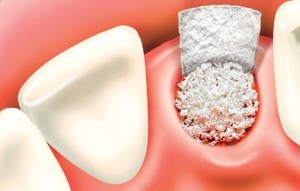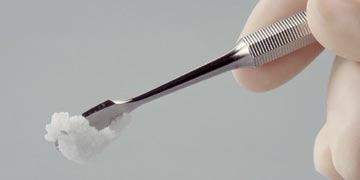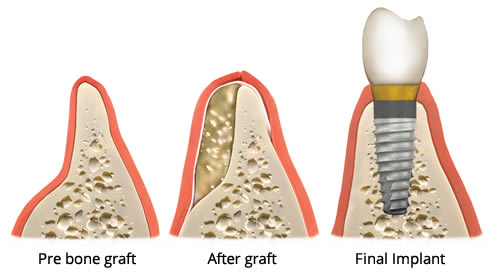In order for the dental implant process to be a success, there must be enough bone in the jawbone to support the implant(s). In cases where the bone under the gum is not wide, tall or dense enough, a bone graft is performed to create a strong foundation of bone for the implant to anchor into. When considering implant surgery, it is important to understand what a bone graft involves, how it is performed and how much it costs.
In This Guide
- Average Cost and Factors
- Sources of Bone Graft Material
- Procedure by Bone Source
- Recovery and Post-Procedure Care
- What to Read Next

Small grafts can be performed by a dentist during implant surgery, while extensive procedures are usually performed by a specialist such as an oral surgeon, prosthodontist or periodontist several months before.
Bone loss can be caused by trauma, an abscess/infection and periodontal disease. In addition, the density of bone beneath missing teeth deteriorates over time. Patients who have been missing teeth for months or years often require bone grafts before they can get implants.
Average Bone Graft Cost
| Single Bone Graft Cost | ||
|---|---|---|
| Simple | Complex | |
| Cadaver, Cow or Synthetic Bone | $250 | $1100 |
| Patient’s Own Bone | $2000 | $3000 |
If a cadaver, cow or synthetic bone is used, the average price of a basic augmentation is around $250-$1100 for a single implant area. Using the patient’s own bone is more expensive and costs $2000-$3000 because it includes two surgical sites as well as hospitalization and anesthesia.
The cost of a bone graft depends upon a number of factors, including the size and shape of the area being worked on, the source material used and where on the bone is harvested from.
Patients may also have to pay additional fees for X-rays ($50-$200), CT scans ($300-$900) or consulting other specialists. For patients who cannot afford the price tag of bone grafts and implants or would rather not wait for the graft to heal, dentures and bridges are the best alternatives to consider.
Dental insurance does not typically cover dental implants, but it may cover part of the cost of a graft if it is deemed to be necessary for the patient’s well-being. For example, if a patient is unable to eat properly due to the bone loss and the problem cannot be resolved by other solutions such as dentures, the procedure should be covered by their health insurance.
Cost of Bone Graft in Other Countries
| Country | Cost |
|---|---|
| Brazil | $1,521 |
| Costa Rica | $283 |
| Croatia | $267 |
| Germany | $1,177 |
| Hungary | $345 |
| India | $2,400 |
| Malaysia | $333 |
| Mexico | $382 |
| Poland | $247 |
| Spain | $958 |
| Thailand | $463 |
| United Arab Emirates | $1,556 |
| United Kingdom | $323 |
4 Sources of Bone Graft Material
The following are the 4 main sources of material used for bone augmentation, listed in order from most effective to least.

Your Own Bone
This source is the safest and most effective because it integrates very well and there is no risk of infectious disease, contamination or tissue rejection. The bone is typically harvested from the chin or jaw, but a shin or hip can also be used. Disadvantages of this source are that it requires two surgical sites, is more expensive and if the bone is taken from the hip or shin, requires general anesthesia and hospitalization.
Human Cadaver Bone
Freeze-dried and sterile, cadaver bone obtained from a reputable tissue bank is more affordable and generally quite safe, although it does carry some risk. Using human bone carries a similar level of risk of transmitting infectious disease to receiving blood from the blood bank.
Animal Bone
Cow bone has been commonly used for many years. It is sterilized and processed to minimize infection, but like human cadaver bone, there is the possibility of contamination. This graft material is naturally absorbed by the body and replaced with real bone over time.
Mineral Bone Substitute (Synthetic)
Although less-effective than the other options, these sterile bone-like materials are second only to a patient’s own bone in terms of safety. This material is also absorbed and replaced over time.
The Procedure
In order to determine if a bone graft is necessary, the extent of grafting required and what source material should be used, panoramic or full-mouth X-rays and/or a CT scan must be taken and analyzed. If the patient’s own bone is to be used, the location it will be harvested from will also be scanned and analyzed.

Chin
First, the oral surgeon administers local anesthesia to both the recipient and donor bone sites. An incision is made in the gum at the recipient site, followed by an incision below the lower front teeth, exposing the chin bone. A block of bone and marrow is removed from the chin.
The surgeon will then cover the area with a layer of tissue or bone substitute to keep the gums from growing into the hole while it heals. After closing the incision at the donor site, the block of donor bone will be placed at the recipient site and anchored in place with small titanium screws which are removed after the recovery period during the implant procedure.
A mixture of marrow and other material is placed around the edges of the block to stimulate bonding. The surgeon then lays down a tissue membrane over the graft before closing the incision.
Shin or Hip
If donor bone is taken from the shin, the surgeon may harvest the bone in the office while administering IV sedation, but if taken from the hip, hospitalization and general anesthesia is necessary. A patient may spend one or two days in the hospital to undergo the procedure. After harvesting the donor bone, it will be placed at the recipient site in the same way described above.
It can take 4-9 months for the augmentation to heal and integrate with the surrounding bone before implants can be placed.
Recovery and Post-Procedure Care
 After the surgery, a patient will be given pain medication, antibiotics and an antibacterial mouthwash. They are advised to avoid certain foods and putting stress on the graft until it heals completely.
After the surgery, a patient will be given pain medication, antibiotics and an antibacterial mouthwash. They are advised to avoid certain foods and putting stress on the graft until it heals completely.
Depending on the size of the graft and the materials used, it can take 4-9 months before the jaw is strong enough to receive implants. During that time, patients are advised to maintain proper oral care (routine brushing and flossing) and a healthy diet to ensure its success.
What to Read Next
- How Much Does a Sinus Lift Cost?
- How to Much Do Dental Implants Cost?
- Dental Implant Problems – What Can Go Wrong
Over to You
Have you had a bone graft done? Or, have you been told you might need one done before you get an implant? Share your experience in the comments!
I am working on my third set of dentures and still have a lot of pain. I am under the care of a prostodontist who is having trouble making dentures which do not hurt. I have had laser surgery and also bone spurs removed in the top of my mouth. I have constant burning and a large gap where the dentist took out some of my bone. I am constantly getting stomach pain from the pain in my mouth. I am going back to the dentist tomorrow because I can not wear the dentures without pain and he just got them back from the lab for the second time. Do you think you can help or should I just wait this is going on since December.
After paying over $3200 dollars my dentist removed a bad tooth molar top jaw and filled it with cadaver implant bone. We waited months for the bone to take and heal and when we went to check on it to see when we could do but implants the bone graft failed due to infection. My dentist did not give me antibiotics. To do another bone graft my dentist wants to charge me another $449 dollars to do another bone graft. Is it right to be charged another $449.00?
Probably not, if you can prove he didn’t give you antibiotics which is bad
Yesterday, I went to a dentist and was told that I needed a root canal and crown for which they charged my credit card $2200+. After drilling out the filling he decided that the crack was too deep and he did an extraction and bone graft. I was refunded $1700. Which put the procedure at $900, same price as the original root canal.
Would this be the right price?
Um – the average price of a basic augmentation is around $250-$1100??? That’s quite a range. What are the factors that raise the price by $850?
Andy, did you get a reply about the price difference?
To Andy and Sharon:
The cost will depend on amount of the grafting material as well as the price set by manufacturer of the those materials.
Depends on the tooth and circumstances. Molars are obviously more since they’re in the back and more awkward to get to. BUT I agree that it’s still a crapload of money
I will be having an implant very soon but I’m hearing that often patients are told that they shouldn’t need a bone graft and then at the time of implant the graft is done. How can I guard against this, and how can I get something other than cadaver or my own bone, if its necessary?
To Mary:
No guarantee; all depends on “open and see’. You should be informed of the possibility of needing graft and the approximate cost.